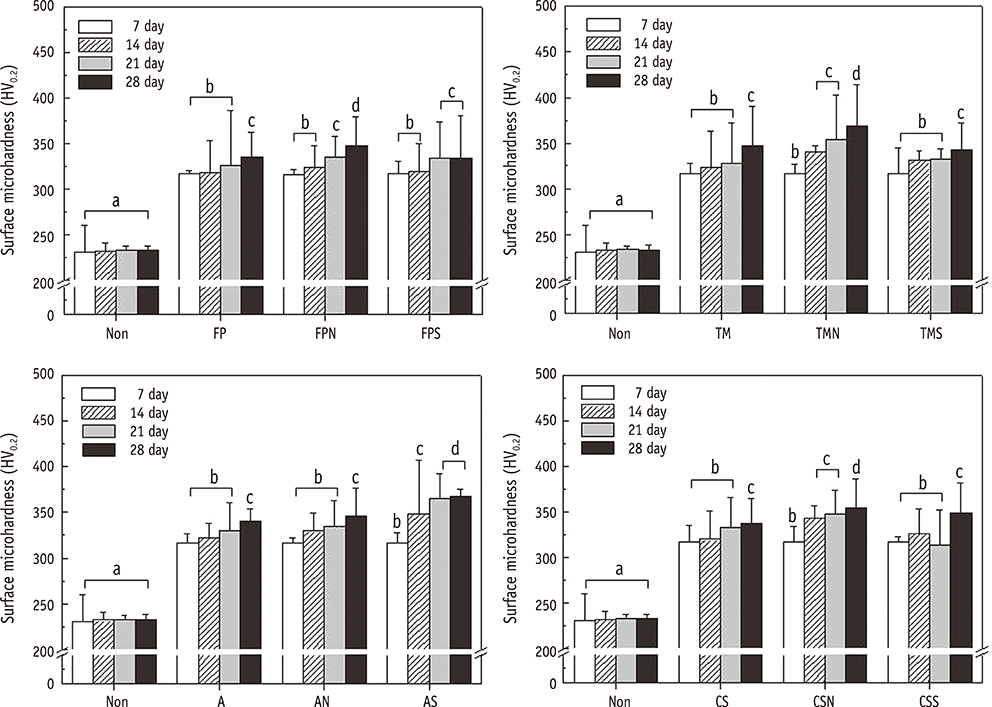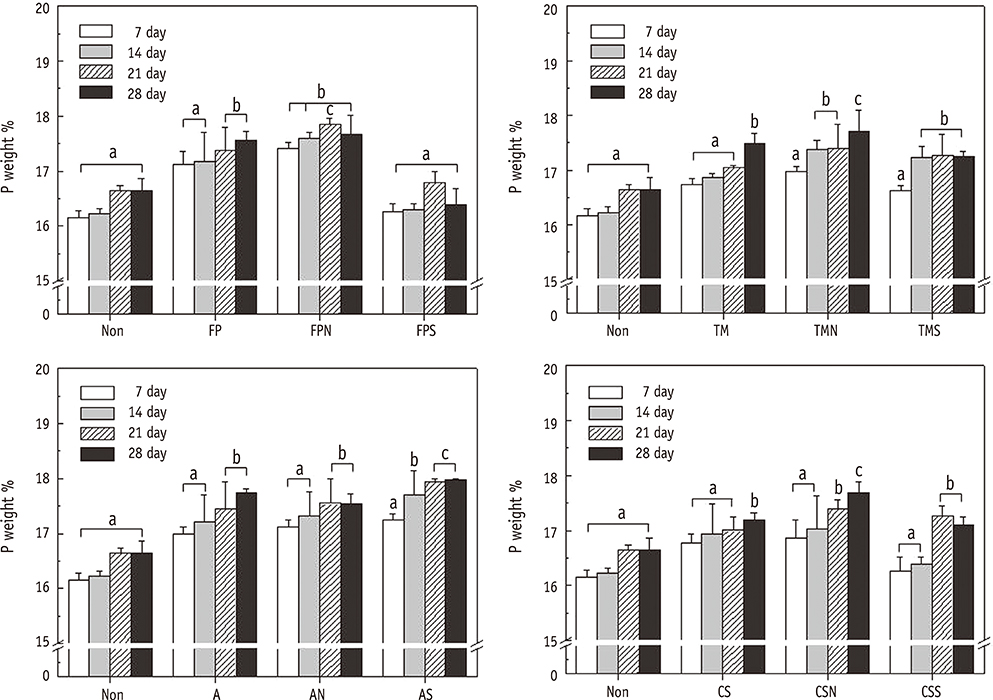Restor Dent Endod.
2016 May;41(2):121-129. 10.5395/rde.2016.41.2.121.
The effect of different fluoride application methods on the remineralization of initial carious lesions
- Affiliations
-
- 1Department of Dental Biomaterials and Institute of Biodegradable Material, Institute of Oral Bioscience and BK21 plus project, School of Dentistry, Chonbuk National University, Jeonju, Korea. bts@jbnu.ac.kr
- KMID: 2163294
- DOI: http://doi.org/10.5395/rde.2016.41.2.121
Abstract
OBJECTIVES
The purpose of this study was to assess the effect of single and combined applications of fluoride on the amount of fluoride release, and the remineralization and physical properties of enamel.
MATERIALS AND METHODS
Each of four fluoride varnish and gel products (Fluor Protector, FP, Ivoclar Vivadent; Tooth Mousse Plus, TM, GC; 60 Second Gel, A, Germiphene; CavityShield, CS, 3M ESPE) and two fluoride solutions (2% sodium fluoride, N; 8% tin(ii) fluoride, S) were applied on bovine teeth using single and combined methods (10 per group), and then the amount of fluoride release was measured for 4 wk. The electron probe microanalysis and the Vickers microhardness measurements were conducted to assess the effect of fluoride application on the surface properties of bovine teeth.
RESULTS
The amount of fluoride release was higher in combined applications than in single application (p < 0.05). Microhardness values were higher after combined applications of N with FP, TM, and CS than single application of them, and these values were also higher after combined applications of S than single application of A (p < 0.05). Ca and P values were higher in combined applications of N with TM and CS than single application of them (p < 0.05). They were also increased after combined applications of the S with A than after single application (p < 0.05).
CONCLUSIONS
Combined applications of fluoride could be used as a basis to design more effective methods of fluoride application to provide enhanced remineralization.
MeSH Terms
Figure
Reference
-
1. Mühlemann HR, Rudolf ER. Fluoride retention after rinsing with sodium fluoride and amine fluoride. Helv Odontol Acta. 1975; 19:81–84.2. Galagan DJ, Knutson JW. The effect of topically applied fluorides on dental caries experience; report of findings with two, four and six applications of sodium fluoride and of lead fluoride. Public Health Rep. 1947; 62:1477–1483.
Article3. Knutson JW, Armstrong WD, Feldman FM. The effect of topically applied sodium fluoride on dental caries experience. Public Health Rep. 1947; 62:425–430.
Article4. Cury JA, Tenuta LM. How to maintain a cariostatic fluoride concentration in the oral environment. Adv Dent Res. 2008; 20:13–16.
Article5. Tenuta LM, Cury JA. Fluoride: its role in dentistry. Braz Oral Res. 2010; 24:9–17.
Article6. Lata S, Varghese NO, Varughese JM. Remineralization potential of fluoride and amorphous calcium phosphatecasein phospho peptide on enamel lesions: an in vitro comparative evaluation. J Conserv Dent. 2010; 13:42–46.
Article7. Lee YE, Baek HJ, Choi YH, Jeong SH, Park YD, Song KB. Comparison of remineralization effect of three topical fluoride regimens on enamel initial carious lesions. J Dent. 2010; 38:166–171.
Article8. ten Cate JM, Jongebloed WL, Arenas J. Remineralization of artificial enamel lesions in vitro. IV. Influence of fluorides and diphosphonates on short- and long-term reimineralization. Caries Res. 1981; 15:60–69.9. American Dental Association Council on Scientific Affairs. Professionally applied topical fluoride: evidence-based clinical recommendations. J Dent Educ. 2007; 71:393–402.10. Ostela I, Karhuvaara L, Tenovuo J. Comparative antibacterial effects of chlorhexidine and stannous fluoride-amine fluoride containing dental gels against salivary mutans streptococci. Scand J Dent Res. 1991; 99:378–383.
Article11. Ellingsen JE, Rölla G. Treatment of dentin with stannous fluoride-SEM and electron microprobe study. Scand J Dent Res. 1987; 95:281–286.
Article12. Paraskevas S, Van der Weijden GA. A review of the effects of stannous fluoride on gingivitis. J Clin Periodontol. 2006; 33:1–13.
Article13. Liu X, Zhou X, Guo B, Jin S, Zhang P. Observation on the inhibiting effect of fluor protector on the demineralization of bovine enamel after exposure to some beverages. Hua Xi Yi Ke Da Xue Xue Bao. 2002; 33:250–252.14. Al Zraikat H, Palamara JE, Messer HH, Burrow MF, Reynolds EC. The incorporation of casein phosphopeptide–amorphous calcium phosphate into a glass ionomer cement. Dent Mater. 2011; 27:235–243.
Article15. Shen C, Autio-Gold J. Assessing fluoride concentration uniformity and fluoride release from three varnishes. J Am Dent Assoc. 2002; 133:176–182.
Article16. Seppä L. Fluoride varnishes in caries prevention. Med Princ Pract. 2004; 13:307–311.
Article17. Cho MJ, Lee HL. A study on the effect of multiapplication of fluoride on enamel remineralization. J Korean Soc Hyg Educ. 2001; 1:125–132.18. Pai N, McIntyre J, Tadic N, Laparidis C. Comparative uptake of fluoride ion into enamel from various topical fluorides in vitro. Aust Dent J. 2007; 52:41–46.
Article19. Crall JJ, Bjerga JM. Fluoride uptake and retention following combined applications of APF and stannous fluoride in vitro. Pediatr Dent. 1984; 6:226–229.20. Lee MS, Park DY, Ma DS. The remineralization effect of topical fluoride agents on artificial enamel caries. J Korean Acad Oral Health. 2012; 36:85–90.21. Ngo H, Ruben J, Arends J, White D, Mount GJ, Peters MC, Faller RV, Pfarrer A. Electron probe microanalysis and transverse microradiography studies of artificial lesions in enamel and dentin: a comparative study. Adv Dent Res. 1997; 11:426–432.
Article22. Kodaka T, Debari K, Yamada M, Kuroiwa M. Correlation between microhardness and mineral content in sound human enamel. Caries Res. 1992; 26:139–141.
Article23. Feagin F, Koulourides T, Pigman W. The characterization of enamel surface demineralization, remineralization, and associated hardness changes in human and bovine material. Arch Oral Biol. 1969; 14:1407–1417.
Article24. Feagin F, Patel PR, Koulourides T, Pigman W. Study of the effect of calcium, phosphate, fluoride and hydrogen ion concentrations on the remineralization of partially demineralized human and bovine enamel surfaces. Arch Oral Biol. 1971; 16:535–548.
Article25. Reynolds EC, Cai F, Cochrane NJ, Shen P, Walker GD, Morgan MV, Reynolds C. Fluoride and casein phosphopeptide-amorphous calcium phosphate. J Dent Res. 2008; 87:344–348.
Article26. ten Cate JM, Featherstone JD. Mechanistic aspects of the interactions between fluoride and dental enamel. Crit Rev Oral Biol Med. 1991; 2:283–296.
Article27. Lee YJ, Kwon TY, Kim YK. In Vitro effectiveness of remineralizing treatments for protecting early carious lesions from further acid dissolution. Korean J Dent Mater. 2013; 40:41–50.28. Crall JJ, Silverstone LM, Clarkson BH, Wefel JS, Wei SH. Fluoride uptake and in vitro caries-like lesion formation in enamel after two-step topical fluoride applications. Caries Res. 1982; 16:162–169.
Article
- Full Text Links
- Actions
-
Cited
- CITED
-
- Close
- Share
- Similar articles
-
- Comparison of the remineralization effect of newly-developed fluoride agents according to the depth of early carious lesions
- Silver Diamine Fluoride Compound for Dental Caries and Its Characterisation Using Microscopic Computed Tomography and Nanoindentation
- Effect of remineralization and inhibition to demineralization after fluoride gel or hydroxyapatite paste application on stripped enamel
- Remineralization ability of fluoride varnish containing tricalcium phosphate by time
- Micro-computed tomographic evaluation of the effect of fluoride agents on white spot lesions: An in vitro study





